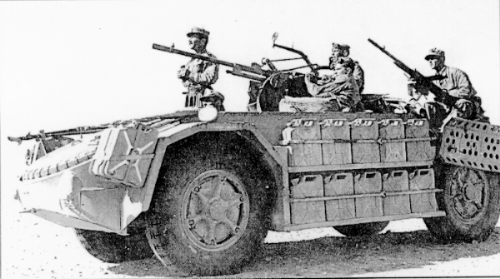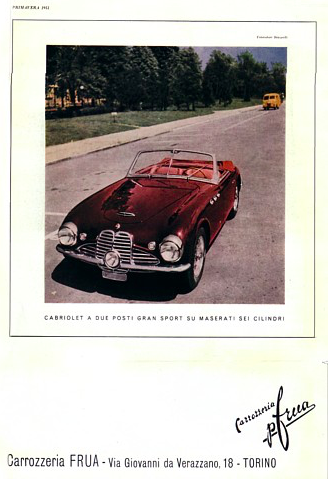The Frua Line
- Ferdinand O. von Galen
- Jan 13, 2018
- 5 min read

(Above: Pietro Frua second from right next to Karl - Heinz Wedel at Waldrestaurant Unterschweinstiege in Frankfurt)
It was September 1982 and Pietro Frua had come to the Frankfurt Motor Show, the IAA to mingle with his many designer confrères he knew would be there. As he sat at the dinner table, next to his old friend Karl-Heinz Wedel of Opel at the Waldrestaurant Unterschweinstiege in Frankfurt, another dinner guest sitting opposite him asked.
“Among your many and varied creations, which ones stand out as your favorites?”
In recent months, since his prostate cancer diagnosis, Frua had wandered down memory lane many times and each time the answer to that very question had been different. So once again, as Wedel smirked knowingly next to him, he once again began to reminisce.
That Pietro would become an automotive designer was written in his genes. After all, his mother Ana was a tailor and his father Carlo employed by FIAT. After finishing school in 1928 at age fifteen, Pietro enrolled at Scuola Allievi FIAT to become a technical draftsman. Only a few months into his studies Frua began his apprenticeship at Stabilimenti Industriali Giovanni Farina (Founded by Giovanni Carlo Farina elder brother of Battista “Pinin” Farina who would go on to found the most famous Italian coachbuilder of all time - Pininfarina.)

It should be noted that during this era Stabilimenti Farina served as a training ground for many of the greatest car designers of the 20th century. In the decade from the late 20’s to the start of World War II, the company saw Pietro Frua, Felice Mario Boano and Giovanni Michelotti put carbon to paper within its hallowed walls. (Right: Stabilimenti Industriali Giovanni Farina)
Frua would remain at Stabilimenti Industriali Giovanni Farina until 1939, his departure sparked by an argument with Attilio Farina, eldest son of the founder and company manager, over Frua’s official role in the company. In the end, Frua’s student, Giovanni Michelotti would succeed him as head of the design staff at Farina and later follow him to Ghia Aigle.
During the war Frua was involved in the design of the SPA – Viberti “Camionetta Sahariana”, a very exotic rear-engined reconnaissance vehicle as well as various sophisticate kitchen ovens and children’s toys. But it was his design for the Belmondo SIMAT and later Velta scooters that were maybe his most influential of the period. It is believed that the little scooter inspired what would one day become the Vespa. (Below: Camionetta Saharina and Belmondo SIMAT scooter.)
His first series production car was introduced in 1958; the Renault Floride / Caravelle. At 117,113 units produced it is by far the most successful car he ever penned. It featured prominently in one of my favorite movies; 1973’s “The Day of The Jackal” starring Edward Fox and Michael Lonsdale. (Below: Renault Floride / Caravelle - Convertible with Sammy Davis Junior)
Next came a little two-door sedan created by Glas, Germany’s smallest automobile firm at the time. Purchased by BMW in 1966, the Glas 1700 would evolve into the BMW 1800/2000 and 1804/2004. The next year, Frua would pen two more models for Glas and BMW; a coupe fastback of which a respectable 5000 were produced and a convertible version which was much rarer at 368 units. Around the same time Frua rekindled a career-long collaboration with Maserati that had started with the first custom bodied Maserati A6G 2000 Spider. That relationship would yield some of Frua’s most iconic cars throughout the 1960’s and 70’s. (Below: Glas 1700 and Maserati A6G 2000 by Frua)
In the early 60’s, after a golden era where Maserati had taken home the Formula 1 title courtesy of Juan Manuel Fangio in the legendary 250 F while simultaneously making its indelible mark on the sports car racing world with the Tipo 61 “Birdcage”, the company was once again in financial trouble and in dire need of cash. Maserati had stopped direct involvement in racing after the 1957 Mille Miglia Guidizzolo Trajedy which had ended the Italian road race for good. However it still sold cars to independent teams like Lloyd "Lucky" Casner’s Casner Motor Racing Division, the Camoradi Team and supplied engines to Cooper’s Formula 1 effort. (Below: Juan Manuel Fangio in the Maserati 250 F at Monaco, the Camoradi Team Tipo 61 Birdcage Maserati and the Cooper Maserati V12 T86 Formula 1 car driven by Jochen Rindt.)
To keep the business going, the Orsi family decided to venture into series production. Their first attempt the 3500 GT/I instantly became a legend using a detuned 3.5 liter racing engine, clothed by Carrozzeria Touring with Frua producing a few special commissions. The evolution of the 3500 was the legendary and super exclusive 5000 GT of which one was styled by Frua. He was getting his foot back in the door. The 3500 GT evolved into the Sebring penned by Vignale and then in 1963 Pietro Frua created his masterpiece and maybe his most famous work of all. The Maserati Mistral. (Below: Maserati 3500 GT by Frua, Maserati 5000 GT by Frua and the Mistral)
Over its seven-year production run 828 coupes were built and 120 spyders. It was the basic design language however that would take Frua almost to the end of his career. In 1963 the Mistral was followed by the Quattroporte Series I and in 1965 and 1967 the English came calling resulting in the AC 428 fastback and spyder based on AC Cobra running-gear. At the same time the relationship with Glas was rekindled with the Glas 2600 V8 and its BMW/ Glass 3000 V8 cousin. The Glas cars were nicknamed “Glaserati” in Germany mocking the resemblance of a lowly Glass to the much more distinguished Maserati Mistral. (Below: BMW/Glas 3000 V8 "Glaserati")

They could laugh all they wanted but the successful formula would live on and come to be called the “Frua Line”. Even more than Glas and BMW, it was Peter Monteverdi who would hang his company’s fate on Frua’s sense of style. From his initial 1967 Monteverdi High – Speed 375 S through its cabriolet and 2+2 variations to the 375/4 saloon, and even the Hai 450 mid-engined Unicorn, Frua penned them all. (Below: Monteverdi 375 High Speed Coupe and Convertible and Hai 450.)
In 1975 Frua penned one last car for Maserati when Alessandro De Tomaso commissioned him to design a new Maserati flagship coupe around the bones of the rather homely De Tomaso Longchamp coupe. Benefiting from Frua’s deft pencil-work and proven Maserati mechanicals, the Maserati Kyalami that Frua showed in 1976 fit the bill. It was a last hurrah as heart problems and ultimately prostate cancer withered away the big man. (Below: Maserati Kyalami, and its frumpy cousin De Tomaso Longchamp.)
In recent years his name has come back to the forefront especially since 2014 when a 1956 Maserati A6G 2000 Gran Sport Berlinetta designed by Frua was discovered as part of the largest barn finds in history. Roger Baillon, founder of Société des Transports R. Baillon a French producer of specialized trucks, and early car collector had bought it in 1959 after the car had represented Maserati at the 1956 Paris Motor Show. It had spent most of its life languishing next to Alain Delon’s Ferrari 250 California Spyder. The Ferrari had been covered by a pile of books.
When the car finally hit the auction block in February 2015 it looked a bit worse for wear and tear but still fetched $2.2 million. The new owner, Jonathan Segel at first planned to have it restored to new but after a thorough service including new spark plugs, oil and Borani wire-wheels it ran and he fell in love with the disheveled look of it. (Below: Baillon Barnfind - Ex Alain Delon Ferrari 250 California Spyder and Baillon's Maserati A6G Gran Sport Berlinetta)
I saw the car on the lawn during “Dawn Patrol” at Pebble beach in 2015 and with the glass smooth waters of Carmel Bay glimmering behind it looked like it had fought in battle and won – a fitting testament to Frua’s legacy and his place among the titans of automotive design.

























































































Comments